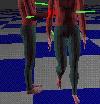Humanoid
A Real-Time and Parallel System
for the Simulation of Virtual Humans
Duration
May 1992 - May 1995
Objectives
Interactive human modelling
Motion control of the human body
Keyframing, Inverse Kinematics, Dynamics
Facial animation
Deformation of the body in motion
Interaction of the human body with the virtual environment
Collision detection
Walking
Grasping
Results
Software:
All software is designed and implemented on Silicon Graphics Workstations and partially ported on transputer systems
The Surface Modeller
The integrated system: TRACK
Motion generation modules
Skin deformation module
Facial animation module
Collision handling module
Quicktime-Movies concerning Collision Detection
 |
Walking characters colliding |
 |
Line of colling characters |
 |
Self-colliding character |
 |
Hand-Arm-Collision |
All animations are recorded realtime with TRACK on a Indigo² Extreme.
Areas rendered in red give visual feedback about intersecting surfaces.
The length of the green vectors shown in the animation indicate the penetration depth of vertices.
The direction of the green vectors indicate in which direction to move in order to resolve or avoid the collision.
This information is used by the Motion Control System to avoid penetrations or semi-automatically correct the motions after detecting self-collisions oder inter-object-collisions.
